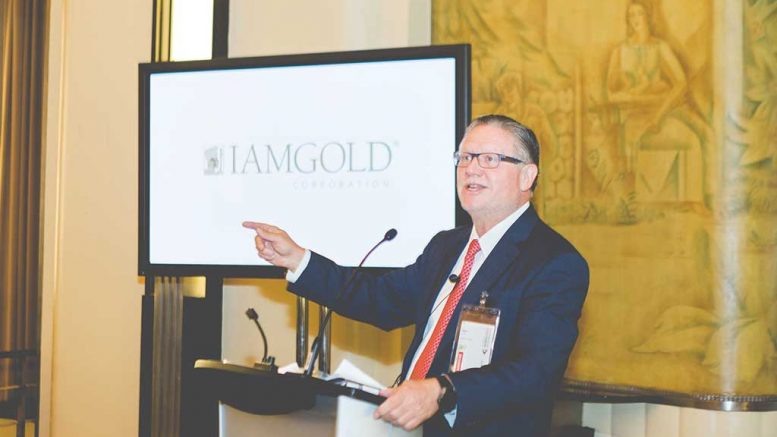The following is a transcript of the keynote speech by Stephen Letwin, president and CEO of Iamgold (TSX: IMG; NYSE: IAG) at the inaugural Progressive Mine Forum presented by The Northern Miner on Oct. 23 in Toronto.
What I want to do is take you through a little bit of my history and hopefully share a little bit of my experiences particularly as they tie in to innovation.
I’m 62 years old. I was born in southern Ontario and raised on a farm and went to school in Ontario. I spent my first couple of years with Procter & Gamble here in Toronto, and then at the tender age of 26 I got headhunted to Calgary, Alberta, and I went to work for a fellow that 95% of you won’t know. Maybe some of you do, or remember he was sort of the Elon Musk of the oil days. His name was Jack Gallagher.
So at 26 I went to work for Jack Gallagher, who was building at that time Canada’s and in fact North America’s largest oil and gas business: Dome Petroleum.
Unfortunately Jack lost his job, lost his company within three years of me getting there — not that I was tied to that, hopefully.
But Jack made the mistake that many of us tend to make, and continue to make, around debt and innovation. I’m going to tie those things together in a little bit.
Jack went out when oil was around US$25 and started acquiring properties, and started to invest in what I call “long cycle” rates of return. Big projects. He was in the Beaufort, he acquired Hudson’s Bay Oil and Gas.
Because he had fallen in love with his own equity, he did it with debt. Sound familiar?

Jack Gallagher
Keep in mind, Jack was a superhuman being. If he was here today, we’d all love the guy. He was very charismatic, very smart, but he made the mistake that many of us do — and I made this mistake — of falling in love with your own equity, and not keeping an eye on what’s going on in innovation.
As Jack piled into long-cycle rates of return projects, people started to change drilling programs in Western Canada: go for shallower wells, go for shorter-cycle economics.
When oil prices fell from US$25 to US$9, and interest rates went from 5% to 21%, that company died. And along with it the dream that Jack had for Canada’s oil and gas exploration program at the time.
The lesson there is: you can never forget about basic economics, you can never forget about your cost structure, and you can never, ever forget about what innovation and the change in technology can do to your business.
It is happening today, it happened a hundred years ago, and it’s going to continue every day, every month, every year, forever. As human beings, it’s easy to forget that.
Because you get on a roll. You get convinced by the marketplace, by your share price that this will never change.
I’m telling you, because I went through it.
So that was my first experience at 26 years of age, and I have not forgotten that. I’ll never forget Jack sitting in the boardroom crying uncontrollably, at the age of 65, because he’d lost his company.
I went from there into the upstream oil and gas business in Calgary and I watched something very interesting. In the mid-1980s to mid-1990s, the belief was there would never be another oil pipeline built in Canada. There was too much oil, oil was trading around US$10, and this would never happen again.

Iamgold president and CEO Stephen Letwin delivers the keynote address to attendees in October at The Northern Miner’s inaugural Progressive Mine Forum at the Carlu in downtown Toronto. Credit: George Matthew Photography.
What happened at that point in time is that companies like Enron started a new model. And this model was: we trade electricity, we trade oil and gas, we do everything online. We’re the smartest guys in the world, and even though we’re running our debt up, even though we’re trading at 100 times multiples, that’s okay.
Enron lasted for almost 10 years. And when I was living in Houston, Texas, working for TransCanada, I got to know the CEO of Enron and the chairman — a hell of a nice guy.
Same experience: selling something that was not sustainable, selling something that had no hard assets behind it, and running up debt until he had a liquidity problem in 2001. And 30,000 people lost their jobs, and one of the major chartered financial institutions — Arthur Andersen — went under. Sound familiar?
Again, too much emphasis on debt, too much emphasis on something that wasn’t backed up by hard assets.
So when I look between Dome and Enron, I look at common things. The balance sheet — Dome forgot about the fact that the little guy could come in and disrupt what they were doing on long-cycle. Enron went the other way and put everything in what I would call fairly non-transparent and “magical” and something the market wanted to grab hold of because they were sick and tired of hearing about oil and gas and pipelines.
As I moved through my career and looked at these things, one would think that when I joined the gold business in 2010 — I’d gone to Harvard, I’d had all these experiences — that I would know exactly what I was doing.
Clearly, I did not. Because when I got into the gold business in 2010, what was happening? Gold was going from US$800 to US$2,000. The industry itself had gone completely into long-cycle. Big mines. Remote places. High cost structures.
What did Steve Letwin do? He should have at that time said, “Wow, our cost structure’s too high. We’re completely betting on long-cycle. We’re not doing anything in innovation. We should be improving our metrics, and changing the model right now.”
I didn’t do any of that. I came to Toronto. The stock price went from US$3 to US$23.50 and I felt like Mick Jagger. Going to restaurants [and waving to people], “Hey!”
Going to market analysts’ meetings and I wasn’t asked one question about cost structure, technology or where you were drilling. It was all about ounces, ounces, ounces. “Tell me how many ounces you’re going to add.”
Not one question about where you were taking the company long-cycle and short-cycle. It was all about how many ounces are you going to deliver.
The ghost of Jack Gallagher should have been in the room with me, saying, “Steve, it’s time you change, because what these guys are driving you to is exactly what they drove me to: failure.”
And that’s exactly where I was headed.
A year and half later when gold turned, in 2012, and dropped from US$1,960 to US$1,057 in 18 months, we lost US$800 million a year in cash flow.
A horrifying experience and we almost — or could have — lost the company.
A couple of things saved us. I woke up, slapped myself across the face and said, “What the hell are you doing?”
We sold some assets, kept the balance sheet strong, reduced our debt and brought people like Tony Moreau — a 33-year-old guy with lots of good ideas around innovation and technology — into the company.

The 57 MW thermal power plant at Iamgold’s Essakane gold mine in Burkina Faso. The plant consists of 11 generators, which operate on heavy fuel oil trucked in from Benin and Togo. Credit: Iamgold.

Iamgold’s 5 MW solar power plant at its Rosebel gold mine in Suriname. Credit: Iamgold.
We changed the whole company from being focused on long-cycle to a short-cycle balance, which brought cash flow in sooner, brought our cost structure down, and at the same time improved our balance sheet.
The stock price had fallen to US$1.50 and you had analysts and people who had purchased stock, I would go to the Denver gold show and people who had purchased Iamgold shares would walk by and look at the ground. Not me, the ground. They didn’t want to look at me. Loser. The worst thing you can do in life is lose somebody’s money. They are unforgiving. Unforgiving. Remember that.
So we changed. The stock now is sitting at $7.50 Canadian. It’s up 600% since then. It’s up 60-70% this year.
Let’s not forget the lessons that we learned: Short-cycle balance with long-cycle balance; not too much debt; do not bet the farm on long-cycle; and always look at innovative ways to change your cost structure.
Always. Every day. Every morning when you get up, think about it.
For that reason I would tell you that I think the gold business has a great future. Because like the oil business in the ‘90s when all investment stopped — nobody thought oil was going anywhere, it was US$9 a barrel — nobody was willing to make a bet.
And because of that, we got short of oil. We had a situation where none of the exploration was done.
The gold business, the metals business is in the same situation today, and as sure as I’m standing here, you’re going to see a response in price because of the lack of exploration that’s been done in this mining field.
I was down in Mexico City. I had 23 guys sitting in a room at the St. Regis Hotel — sons of multi-billionaires in Mexico. Collectively, these 40 year olds were worth US$245 billion. Not one of them owns a gold stock.
That should sound depressing. It actually wasn’t. I thought, here’s an indication of where people are putting their money: Tesla, crypto-currencies, everything related to technology that’s exciting.
I think you’re going to see a turn, and we need to be ready for the turn. Let’s continue to innovate. Let’s continue to bring our cost structure down — whether that’s ore sorting technology, X-ray technology, thinking about short-cycle versus long-cycle.
Let’s keep doing what we’re doing, and when this turns — and it will turn — we will get the benefits of that.
And when it does turn, let’s not be crazy again. Let’s keep the discipline. There are companies that have done that. There are very few, but they are out there.

Anthony Moreau, business development & innovation manager at Iamgold.
How much do you think gold is up since 2002? Three hundred and sixty percent. Gold has moved on average 11% every year for 16 years.
How many companies have actually seen their market cap improve? Out of 200, five. Do you think there’s a confidence issue?
Yes, and it’s around cost structure and innovation.
I’m so glad we’re doing this conference. It’s a reminder that innovation is absolutely critical to efficiency, staying ahead of the game, and making sure most importantly that your shareholders are getting the best value for their money.
Because without it, you will not stay ahead of the game.
And these crypto-currencies — which I cannot explain. Tony’s tried and I’m thick here — I have no idea why Bitcoin is at US$195 billion. I wish I would have invested. But I’ve made it a point when I don’t understand something, not to invest in it. We saw the dot-coms in the late ‘90s.
But right now my focus is on cost structure, balance sheet, innovation, bringing costs down so that we last for the long term.
So, when four out of 10 Canadians are $200 away from not being able to make their next credit card payment, I get a little concerned about debt, and I get a little bit concerned about where we’re putting our money.
In the mining space, my perspective is that putting money into it is a good bet right now because we’ve had such a long dry spell of exploration.
Watch the recorded livestream of Stephen Letwin’s keynote speech at the Progressive Mine Forum on The Northern Miner’s YouTube channel (from 9:03 to 26:47):





As part of a group that focuses on costs, this is music to my ears. Every deposit has a “sweet spot” and bigger is not always better. The best project may not be the 500 million ounces in the ground versus the project with 500,000 ounces. Bottom line, costs matter. Great conference and great talk! Thank you.
I am shareholder from IAMGOLD
Should I augment my shares quantity, now?
great!!